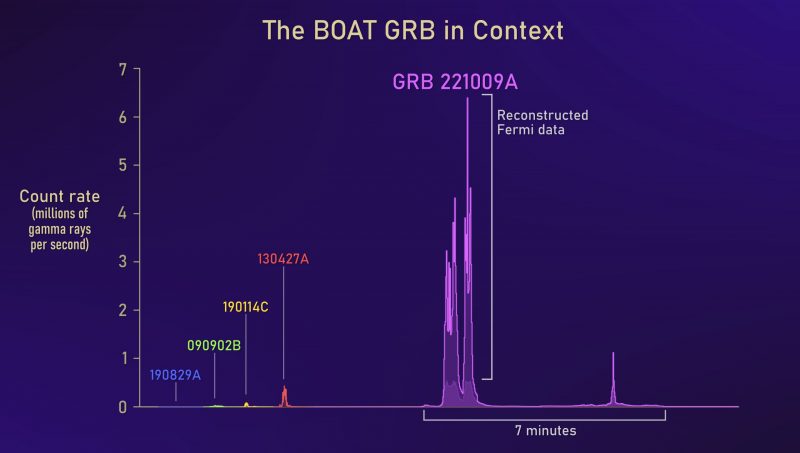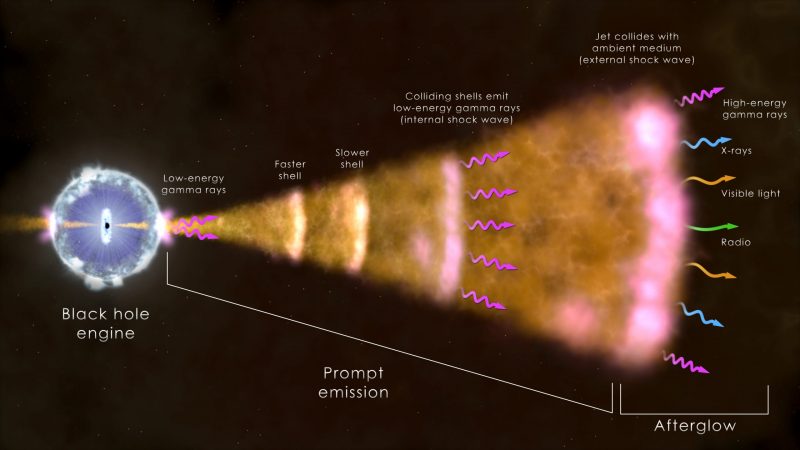
This story is taken primarily from a press release from the European Space Agency, on March 28, 2023. Additions and edits by EarthSky.
Brightest gamma-ray burst
On October 9, 2022, the brightest gamma-ray burst (GRB) ever detected lit up monitors across Earth. Nicknamed BOAT for brightest of all time, the blast is thought to have been from a star becoming a black hole. It was so powerful that it disturbed Earth’s ionosphere from 2.4 billion light-years away. And its x-ray radiation illuminated dust in our Milky Way galaxy, creating the apparent concentric rings seen in the image above (the increase in size is really a perspective effect, with the largest ring the closest to us). One of the scientists commented:
The difference between your typical gamma-ray burst and this one is about the same as the difference between the light bulb in your living room and the lit-up floodlights in a sports stadium.
Astronomers scrambled to point their telescopes at the gamma-ray burst, which is now known as GRB 221009A. Many studied it. And some said it provided:
… an unprecedented look at the structure of the Milky Way and a new understanding of the sources of subatomic particles zipping through our planet.
Astronomers presented their new findings at the High Energy Astrophysics Division meeting of the American Astronomical Society in Waikoloa, Hawaii, on March 28, 2023. A flurry of press releases from around the world accompanied the presentation.
Last chance to get a moon phase calendar! Only a few left. On sale now.
All eyes on the brightest gamma-ray burst
Now, as always, mysteries remain. Consider, for example, that the gamma-ray burst is thought to have come from a very massive star that exploded as a supernova, at the same time collapsing to form a black hole. One mystery is that, as yet, the debris from the explosion appears to have disappeared without trace. More about that below.
The gamma ray burst itself was first seen at Earth several months ago. NASA’s Neil Gehrels Swift Observatory first detected X-rays from GRB 221009A on October 9, 2022. At first, the source of the burst appeared to be in our Milky Way, not far from the galactic center.
But then Swift and NASA’s Fermi Gamma-Ray Space Telescope provided more data, which soon suggested the source was much farther away.
Observations from the European Southern Observatory’s Very Large Telescope then pinpointed the burst to a distant galaxy behind our own.
Being much further away, around 2 billion light-years instead of several tens of thousands, meant that the GRB was exceptionally bright: the brightest ever seen.

A 1-in-10,000-year burst
Statistically, scientists only expect a gamma-ray burst as bright as GRB 221009A to happen once in many thousands of years. This burst may even be the brightest gamma-ray burst since human civilization began. Alicia Rouco Escorial, an ESA Research Fellow who studies GRB, said:
This has been a very eye-opening event. We have been very lucky to witness it.
Calculations show that for the few seconds it lasted, the blast deposited around a gigawatt of power into Earth’s upper atmosphere. That’s the equivalent of a terrestrial power station’s energy output. Erik Kuulkers, ESA Project Scientist for Integral, one of the spacecraft that detected the GRB, said:
So many gamma rays and X-rays were emitted that it excited the ionosphere of the Earth.

Studying the GRB
The event was so bright that even today scientists can see the residual radiation – the afterglow – and it will remain for a long time. Volodymyr Savchenko, University of Geneva, Switzerland, who is currently analyzing the Integral data, said:
We will see the afterglow of this event for years to come.
Scientists are now bringing together the large amount of data from different instruments to understand the original explosion. They also want to know how the radiation interacted with other matter on its journey through space.
Shockwave rings in dust clouds
One area that already yielded scientific results is the X-rays that illuminated dust clouds in our galaxy. The radiation traveled through intergalactic space for around 2 billion years before entering our galaxy. It then encountered the first dust cloud around 60,000 years ago, and the last one about 1,000 years ago.
Each time the X-rays encountered a dust cloud, it scattered some radiation, creating concentric rings that appeared to expand outward. ESA’s XMM-Newton observed these rings for several days after the GRB. The closest clouds produced the largest rings simply because they appear bigger by perspective.
Andrea Tiengo of Scuola Universitaria Superiore IUSS Pavia in Italy analyzed the data with a team to find the distance to the dust clouds. Tiengo said:
The first cloud it hit appears to be on the very edge of our galaxy, far from where galactic dust clouds are usually observed.
Over the years, astronomers have proposed a number of different properties for the dust grains. So, Tiengo and colleagues were able to test them against the X-ray data. The model that reproduced the rings extremely well had dust grains composed mostly of graphite. They also used their data to reconstruct the X-ray emission from the GRB itself, because no instrument directly observed that particular signal.

A remaining mystery
But a mystery remains about the object that exploded to create the GRB. Andrew Levan and colleagues used the Webb and Hubble space telescopes to look for the aftermath of the explosion … and found nothing. Levan said:
That’s weird, and it’s not totally obvious what it means.
It could be that the star was so massive that following the initial explosion, it immediately formed a black hole that swallowed the material that would traditionally make the gaseous cloud known as a supernova remnant.
So, there is a lot of follow-up work as astronomers continue to search for the remains of the star that exploded. One thing they will look for is traces of heavy elements such as gold, which scientists think massive explosions can produce.
Bottom line: The brightest gamma-ray burst of all time – or at least so far – blasted into the collective consciousness of earthly astronomers on October 9, 2022. It affected dust in our Milky Way galaxy and disturbed Earth’s ionosphere. The burst is thought to have been born when a star exploded as a supernova, at the same time collapsing to form a black hole. But, as yet, the Webb and Hubble space telescopes have failed to detect any supernova remnant.
Source: The Power of the Rings: The GRB 221009A Soft X-Ray Emission from Its Dust-scattering Halo
Source: Focus on the Ultra-luminous Gamma-Ray Burst GRB 221009A











